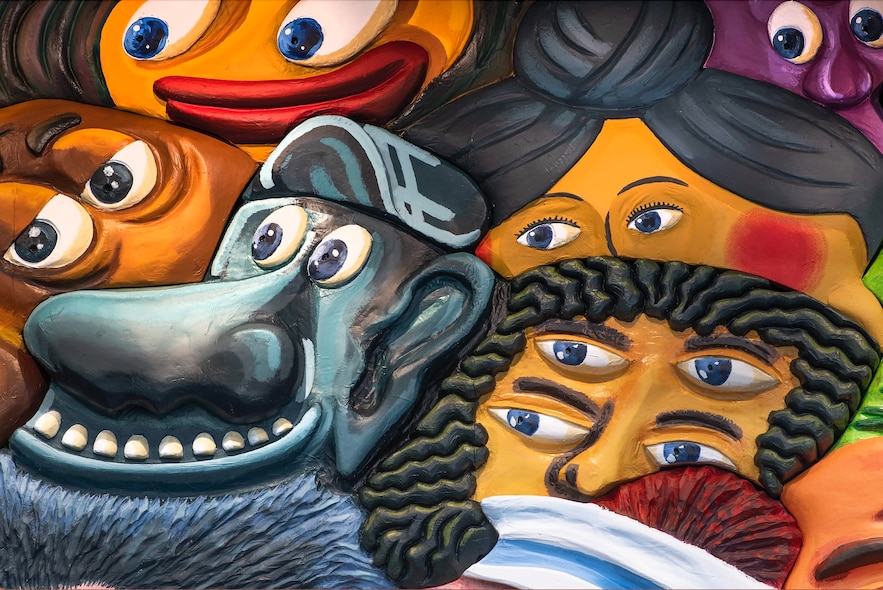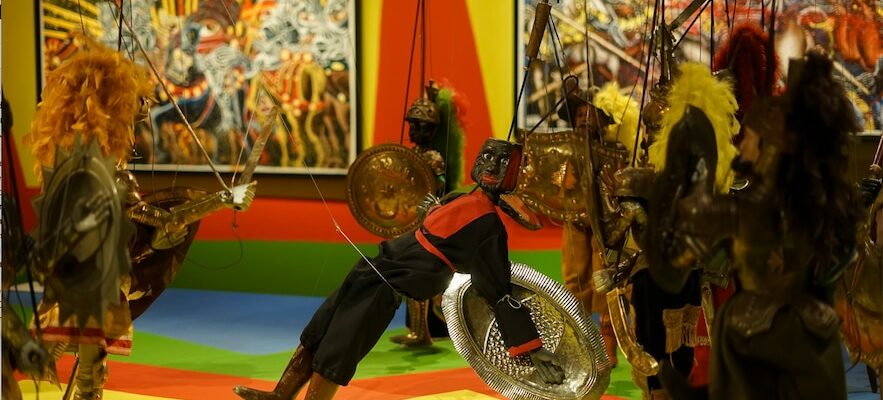It is the big trend of recent years: to make the works of an artist dialogue with those of a museum fund. The formula, now almost banal, often has the merit of exhuming pieces rarely shown and of making an unprecedented rapprochement between the universes, the eras. After Macha Makeïeff this fall, it’s Hervé Di Rosa’s turn to highlight original pieces drawn from the Mucem collections. Faced with this profusion of furniture and objects from popular arts and traditions, the cantor of free figuration of the 1980s saw it “as an air of family” with yum, the International Museum of Modest Arts which he created with Bernard Belluc in Sète, his hometown, nearly twenty-five years ago. A “family air” which also gives its title to the Marseille meeting. This is like the voluble Sétois, itself a compulsive collector: a joyful bric-a-brac spread over fifteen islets, between which the visitor navigates, Vincent Giovannoni and Jean Seisse, commissioner and scenographer of the exhibition, having resolutely banished the physical barriers between the pieces and those who look at them.
Hervé Di Rosa and Jean Seisse (artistic direction) unroll a route of islets at Mucem.
/ © Julie Cohen / Mucem
The approach fully joins that of the multidisciplinary and inveterate globetrotter creator that is Hervé Di Rosa: question the limits between art, the artist and people, whether or not they come to the museum in our digital era saturated with images. He knows for a long time that the world moves, that the modes are turning, the old follower of ceramics, which has seen the mixing between art and crafts, long snubbed by contemporary art, at a time when the video installation and the conceptual were kings. Already, a student at the end of the 1970s, the young Di Rosa surrendered with greedy the rooms of the Museum of Popular Arts and Traditions of Bois de Boulogne: “There were these ecological units which reconstructed traditional interiors, that fascinated me,” he recalls. In the reserves of the Mucem, located at La Belle de Mai, he was first and naturally magnetized by the objects referring to the carnival, the fair and the grotesque images, but quickly turned away from it: “I thought it would be redundant with my work which is partly influenced by these universes,” he explains. “With Vincent Giovannoni and Jean Seisse,” we were therefore focused on more simple objects Old furniture, coupling parts or bowling game balls. “
In Mucem, the artist, wanted to “bury” his discoveries gleaned from the beautiful of May in his own creations. And vice versa. In fact, these “auctions” offer new perspectives to the imagination by going beyond the simple look between two works to create a new one. The result is often spectacular if not always obvious, but that was the objective of Hervé Di Rosa: to offer “a kind of treasure hunt for those who will try to find correlations – which will sometimes prove to be distant – between the works”. Thus, before our eyes, a ladder of horizontal beef yoke overlooks a cow in resin painted by the artist; A cohort of colorful figurines from his personal collection arise from an old Norman wardrobe; An impressive cement, metal, coal and electric wire model pays tribute to the minors and the sorters of the last century; Or even, concession to the fairground arts affected by Di Rosa, a monumental organ with 1,040 pipes activated by a superb, superb tire system like an insubmersible vessel. To revive the instrument with 105 keys, the artist asked the musicians Pascal Comelade and Régis Campo to associate each with a composition that the visitor can listen to helmet on the ears.

At Mucem, view of “visitors” (detail), by Hervé Di Rosa.
/ © Adagp Paris 2025 © Pierre Schwartz
Not far from there, an imposing rifle, once used for water game, sits in the middle of wooden birds. The volatiles, shaped on the family kitchen table by Marius Di Rosa, the recently disappeared artist’s father, were intended to play the “hunting callers” on the ponds. They rocked Hervé’s childhood, and come to join, as a symbol, this eclectic meeting of “popular objects with intrinsic beauty that we all had before our eyes, but whose value and materiality we have not always perceived”. The paternal tribute is doubled here from an ode to diversity embodied by the Marseille city and its inhabitants. In the museum reception hall, THE Visitorsa 7-meter papier mache bas-relief appearing a host of composite faces, announce the color. We find this theme over the course, on a large canvas, Marseillaisbut also through the cut -off metal plates of 4 meters by 3 meters, where Di Rosa takes over the famous “resilses” of Rudy Ricciotti, the designer of Mucem. The loop is completed, the jack-of-all-trades at home.
